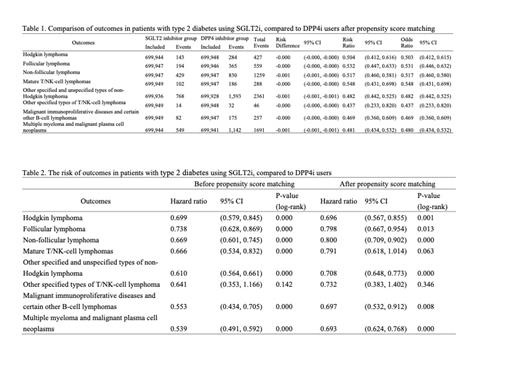Objective: Type 2 diabetes mellitus (T2DM) and cancer are among the top ten leading cause of death in the United States of America [1, 2]. It is well-known that T2DM and cancer share several common risk factors including hyperinsulinemia, obesity, chronic inflammatory status and advancing age. Recent observational studies revealed that diabetic patients are associated with modest increased risk of various blood cancers, including lymphoma and leukemia [2, 3]. Despite being a drug of choice for diabetic patients with chronic kidney disease or cardiovascular disease [4-7], contemporary data regarding the relationship sodium glucose cotransporter-2 inhibitors (SGLT-2i) and incidence of hematological malignancies remains elusive. Our study aims to assess the association between SGLT-2i and lymphoma in patients with T2DM compared to other oral antidiabetic drugs.
Methods: This was a population-based cohort study based on electronic health records from 92 hospitals in the United States. Patients aged over 18 years with T2DM who were initiated treatment with SGLT-2i or DPP-4i between 2015 and 2023 were retrieved. Patients with type 1 diabetes or pre-existing malignancy were excluded. Cohorts were grouped into SGLT-2i or DPP-4i and were 1:1 propensity score matched for age, sex, ethnicity, comorbidities, and medication history. The primary outcome was newly diagnosed lymphoma and myeloma, including, Hodgkin lymphoma, B-cell lymphoma, T-cell/natural killer (NK)-cell lymphoma and plasma cell neoplasm. Hazard ratios (HRs) and 95% confidence intervals (95% Cis) were calculated using the Cox proportional hazard regression model. Kaplan-Meier analysis and log-rank tests were used to compare the outcomes across the cohorts.
Results: There were a total of 1,877,388 adults with T2DM and were started on SGLT-2i or DPP-4i. The final study population after 1:1 propensity score matching included 1,399,898 patients, with 46.4% of which being females. The remaining baseline characteristics were balanced between the two group, including chronic kidney disease, heart failure and advance age. There were 5,197 incident cases of lymphomas and 1,691 incident cases of plasma cell neoplasm. SGLT-2i was associated with a significantly lower risk of developing various hematological malignancy including Hodgkin lymphoma (aHR 0.696; 95% CI 0.567-0.855), follicular lymphoma (aHR 0.798; 95% CI 0.667-0.954), non-follicular lymphoma (aHR 0.800; 95% CI 0.709-0.902), and malignant plasma cell neoplasm (aHR 0.693; 95% CI 0.624-0.768)
Conclusion: The use of SGLT-2i was associated with a reduced risk of developing various lymphoma and myeloma, including Hodgkin lymphoma, non-Hodgkin lymphoma, and malignant plasma cell neoplasm, when compared to DPP-4i use. Further investigations are warranted to elucidate the mechanism and pathophysiology behind these findings.
Reference
1. Cronin, K.A., et al., Annual report to the nation on the status of cancer, part 1: National cancer statistics. Cancer, 2022. 128(24): p. 4251-4284.
2. Giovannucci, E., et al., Diabetes and cancer: a consensus report. Diabetes Care, 2010. 33(7): p. 1674-85.
3. Gong, I.Y., et al., Association between diabetes and haematological malignancies: a population-based study. Diabetologia, 2021. 64(3): p. 540-551.
4. Evans, J.M., et al., Metformin and reduced risk of cancer in diabetic patients. BMJ, 2005. 330(7503): p. 1304-5.
5. Foretz, M., et al., Metformin: from mechanisms of action to therapies. Cell Metab, 2014. 20(6): p. 953-66.
6. Richardson, L.C. and L.A. Pollack, Therapy insight: Influence of type 2 diabetes on the development, treatment and outcomes of cancer. Nat Clin Pract Oncol, 2005. 2(1): p. 48-53.
7. Wu, W., et al., The association of diabetes and anti-diabetic medications with clinical outcomes in multiple myeloma. Br J Cancer, 2014. 111(3): p. 628-36.
Disclosures
No relevant conflicts of interest to declare.


This feature is available to Subscribers Only
Sign In or Create an Account Close Modal